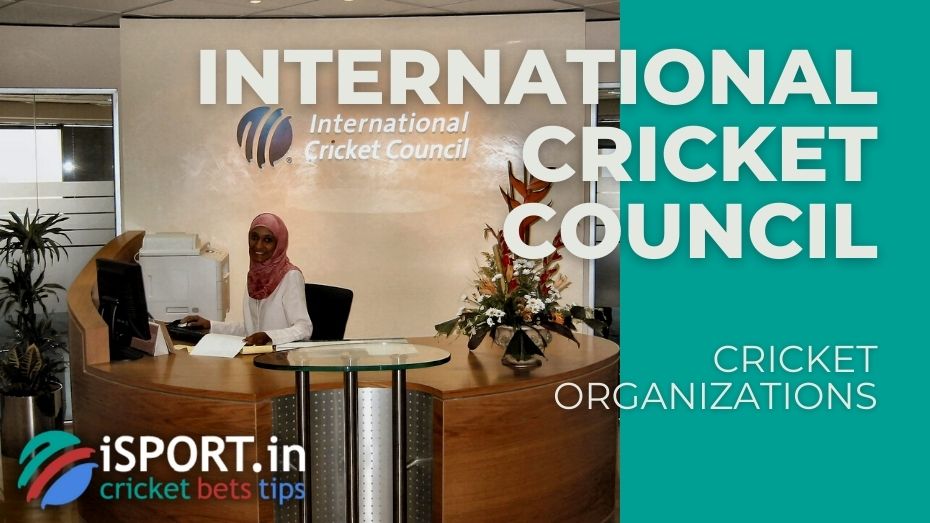International Cricket Council

Each sport has a major international organization that oversees key processes. FIFA is in footbal, the International Cricket Council in cricket. At the moment, 106 national associations are members of the council. Also, there are five regional federations in cricket, which we will talk about in this article.
International Cricket Council: history of creation
The main governing body in cricket was established in 1909. In 1907, the South African Cricket Association president, Abe Bailey, contacted the secretary of the British Marylebone Cricket Club, F.E. Lacey, and suggested creating an association responsible for running the competition and structuring the rules. In addition to England, Abe Bailey made an offer to the Australians, but they refused. As a result, another year and a half passed when Bailey achieved his goal. The association was called the Imperial Cricket Conference and included South Africa, England and Australia. Soon, these countries met again to agree on all the points of the rules and discuss the dates of the first matches against each other. The debut series of confrontations between the national cricket teams from South Africa, England and Australia began in 1912 in England. Subsequently, the Imperial Cricket Conference expanded:
- In 1926, doubled. It included India, West Indies and New Zealand.
- The seventh country in the Imperial Cricket Conference was Pakistan in 1947. True, South Africa withdrew from the composition in 1961 and returned only in 1991.
The International Cricket Council appeared in 1965, and the current name was attached to the organization only 12 years later. The International Cricket Council had 20 members in 1990. In the 90s of the 20th century, the number of association members increased by eight more. By 2010, there were 40 national federations in the main cricket organization. The big spike happened in 2017. The last to join the International Cricket Council is the US federation.
International Cricket Council: features
The International Cricket Council has three types of members:
- Full members. Only 11 national federations have this status. These include the three founders Australia, England and South Africa, as well as Afghanistan, Bangladesh, India, Ireland, New Zealand, Sri Lanka, the West Indies and Zimbabwe.
- Associate members. 38 national federations have this status.
- Affiliated members. 57 national federations.
Note that the national teams must have the status of a full-fledged member to participate in test matches. Associate members are also eligible to participate in competitions using the ODI and Twenty20 formats. Since its inception, the headquarters of the main international organization in cricket has been located in London. In 2005 it moved to Dubai (UAE). This decision was due to the fact that the International Cricket Council was unable to obtain a special tax exemption from the British government. The British government did not want to create a precedent. Subsequently, other sports organizations could apply for this right. After the International Cricket Council headquarters moved to Dubai, the branches remained for a while in London and Monaco, but they were soon closed.
In addition to the desire of the International Cricket Council to move a large company of employees to a country with the best taxation, the organization pursued the goal of getting closer to the “main force of cricket” – the Asian region. Given the growing popularity of cricket in India and Pakistan, overseeing teams’ activities from another continent was not the most effective solution.
The International Cricket Council does not control bilateral friendly matches and domestic championships for countries that are members of the council. The main organization in the world of cricket has not changed the game’s rules that have existed since 1788. Then they were established by the Marylebone Cricket Club.
There were already 10 directors in the history of the International Cricket Council. The council is now chaired by Alan Isaac from New Zealand, who took over in 2012. He has held the post for the longest term of any predecessor.
International Cricket Council: sources of income
The main organization in the world of cricket organizes the largest international competitions. First of all, the World Cup is worth mentioning. The proceeds from this event are distributed among all members of the International Cricket Council. They earn the most from the sale of television broadcasting rights.
The International Cricket Council also hosts friendly matches of the national teams. At the same time, the main international organization in the world of cricket has no dividends from them. In the middle of the last decade, the International Cricket Council decided to create other activities that will help increase profits. Thus, the ICC Super Series appeared in the calendar, the matches of which were first played in Australia in 2005. True, the tournament was not successful, and the following season, under pressure from India, was canceled.
The ICC World Twenty20 tournament, which has been held since 2007 until now, turned out to be much more successful. The ICC Champions Trophy has been played since the end of the last century.
International Cricket Council: regional federations
In addition to the international organization, cricket, like any other sport, has regional federations. There are five of them at the moment:
- the African Cricket Association. Founded in 1997, it consists of 22 national federations. Its headquarters are located in Benoni (South Africa).
- the Asian Cricket Council. Founded in 1983, it includes 24 national federations. Its headquarters are located in Colombo (Sri Lanka).
- the ICC Americas. Founded in 2000, with 17 national federations. The headquarters is located in Colorado Springs (United States).
- the ICC East Asia-Pacific. Founded in 1996 with 11 members. It is headquartered in Melbourne (Australia).
- the European Cricket Council. Founded in 1997, it includes 34 national federations. The headquarters are located in London (England).
Previously, there were two councils in Africa, instead of the African Cricket Association: the East and Central Africa Cricket Council and the West Africa Cricket Council. After the creation of the association, their status was abolished.
